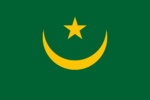Knowledge fuels change
For over a decade, Energypedia has shared free, reliable energy expertise with the world.
We’re now facing a serious funding gap.
Help keep this platform alive — your donation, big or small, truly matters!
Thank you for your support
Difference between revisions of "Mauritania Energy Situation"
***** (***** | *****) m |
***** (***** | *****) m |
||
| Line 2: | Line 2: | ||
{| cellspacing="0" cellpadding="0" border="1" style="width: 400px; float: right" | {| cellspacing="0" cellpadding="0" border="1" style="width: 400px; float: right" | ||
|- | |- | ||
| − | | style="text-align: center | + | | colspan="4" style="text-align: center" | '''Islamic Republic of Mauritania''' |
|- | |- | ||
| [[File:Mauritania Flag.png|border|center|150px|Mauritania Flag.png|alt=Mauritania Flag.png]]<br/> | | [[File:Mauritania Flag.png|border|center|150px|Mauritania Flag.png|alt=Mauritania Flag.png]]<br/> | ||
| Line 92: | Line 92: | ||
|} | |} | ||
| − | {| cellspacing="1" cellpadding="1" border="0" align="left" style="width: 350px | + | {| cellspacing="1" cellpadding="1" border="0" align="left" class="FCK__ShowTableBorders" style="width: 350px" |
|- | |- | ||
| __TOC__ | | __TOC__ | ||
| Line 98: | Line 98: | ||
|} | |} | ||
<div style="clear: both"></div> | <div style="clear: both"></div> | ||
| − | = Overview = | + | = Overview<br/> = |
| + | (give a short overview of the country's energy situation, status quo including energy supply and consumption. If this is too much information, split into sub headings) | ||
| + | = Energy Sources<br/> = | ||
| − | == | + | == Hydropower == |
| + | == Solar Energy == | ||
| + | == Biomass == | ||
| − | == | + | == Biogas == |
| + | == Wind Energy == | ||
| + | == Geothermal Energy == | ||
| − | == | + | == Fossil Fuels == |
| + | = Key Problems of the Energy Sector = | ||
| + | = Policy Framework, Laws and Regulations = | ||
| − | == | + | == General Energy Policy, Energy Strategy<br/> == |
| + | == Important Laws and Regulations == | ||
| + | == Specific Strategies == | ||
| − | + | (Biomass, Renewable Energies, Rural Electrification, Energy Access Strategy, Poverty Reduction Strategy etc.)<br/> | |
| − | + | = Institutional Set-up in the Energy Sector = | |
| − | |||
| − | |||
| − | |||
| − | |||
| − | |||
| − | |||
| − | |||
| − | |||
| − | |||
| − | |||
| − | |||
| − | |||
| − | |||
| − | |||
| − | |||
| − | |||
| − | |||
| − | |||
| − | |||
| − | |||
| − | |||
| − | |||
| − | |||
| − | |||
| − | |||
| − | |||
| − | |||
| − | |||
| − | |||
| − | |||
| − | |||
| − | |||
| − | |||
| − | |||
| − | |||
| − | |||
| − | |||
| − | |||
| − | |||
| − | |||
| − | |||
| − | |||
| − | |||
| − | |||
| − | |||
| − | |||
| − | |||
| − | |||
| − | |||
| − | |||
| − | |||
| − | |||
| − | |||
| − | |||
| − | |||
| − | |||
| − | |||
| − | |||
| − | |||
| − | |||
| − | |||
| − | |||
| − | |||
| − | |||
| − | |||
| − | |||
| − | |||
| + | = Activities of Donors and Implementing Agencies<br/> = | ||
= Further Information = | = Further Information = | ||
*[http://www.mauritania.mr/fr/index.php Official website]<br/> | *[http://www.mauritania.mr/fr/index.php Official website]<br/> | ||
| − | *[https://www.cia.gov/library/publications/the-world-factbook/geos/mr.html Mauritania entry at The World Factbook] | + | *[https://www.cia.gov/library/publications/the-world-factbook/geos/mr.html Mauritania entry at The World Factbook] |
| + | |||
| − | |||
| − | = References | + | = References = |
<references /> | <references /> | ||
| + | [[Category:Country_Energy_Situation]] | ||
[[Category:Mauritania]] | [[Category:Mauritania]] | ||
| − | |||
Revision as of 13:48, 22 August 2013
| Islamic Republic of Mauritania | |||
|
Capital |
Nouakchott (18°09′N 15°58′W) | ||
|
Official language(s) |
Arabic | ||
|
Government |
Islamic republic | ||
|
President |
Mohamed Ould Abdel Aziz | ||
|
Prime Minister |
Moulaye Ould Mohamed Laghdaf | ||
|
Total area |
1,030,700 km2 | ||
|
Population |
3,291,000 (2009 estimate) | ||
|
GDP (nominal) |
$3.029 billion | ||
|
GDP Per capita |
$975 | ||
|
Currency |
Ouguiya (MRO) | ||
|
Time zone |
CET (UTC+00) | ||
|
Calling code |
+222 | ||
Overview
(give a short overview of the country's energy situation, status quo including energy supply and consumption. If this is too much information, split into sub headings)
Energy Sources
Hydropower
Solar Energy
Biomass
Biogas
Wind Energy
Geothermal Energy
Fossil Fuels
Key Problems of the Energy Sector
Policy Framework, Laws and Regulations
General Energy Policy, Energy Strategy
Important Laws and Regulations
Specific Strategies
(Biomass, Renewable Energies, Rural Electrification, Energy Access Strategy, Poverty Reduction Strategy etc.)
Institutional Set-up in the Energy Sector
Activities of Donors and Implementing Agencies
Further Information




















